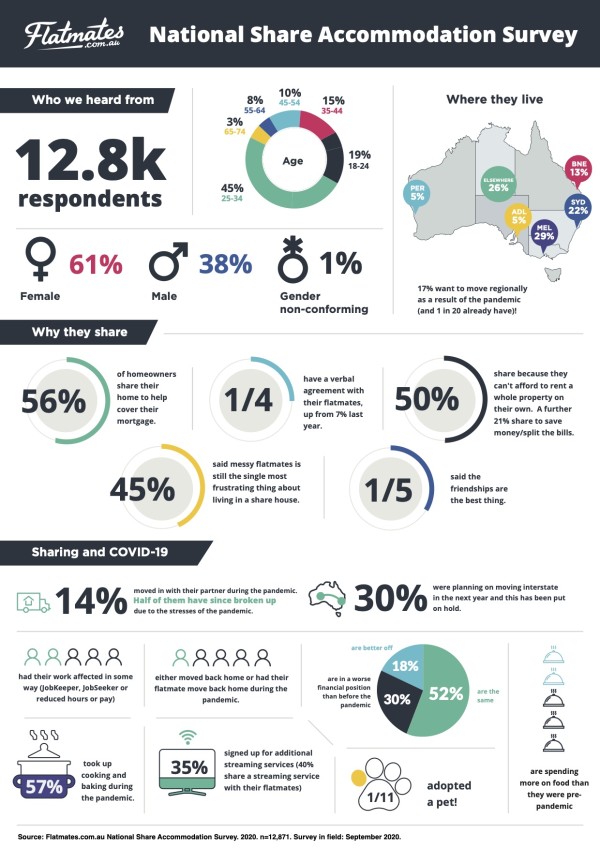How COVID-19 has affected people living in share houses
Almost 13,000 flatmates let us know what it’s been like living in a share house during the pandemic. For some, it’s been amazing (18% are in a better financial position). But for others, 2020 has been riddled with stress, with 1 in 5 worried they would be evicted.

Sharing and COVID-19
Stresses from the pandemic have affected every surface of shared living (but most share houses are used to a dirty kitchen surface or two). People living in share houses are usually some of the youngest independent Australians and due to their age, casual work and study commitments, they’re also some of the most disadvantaged financially. Thanks to our 2020 National Share Accommodation Survey, we know that 50% of sharers live in a share house because they can’t afford to rent by themselves and a further 21% share to save money and split the bills. So already, Flatmates.com.au’s community is surrounded and focused on their financial situation. Add a pandemic to the mix and we suddenly have 2 in 5 out of their regular work and on JobKeeper, JobSeeker or reduced hours/pay.
Only half of respondents who asked for a rent reduction were granted one and because of this, 1 in 5 respondents moved back home to the security of their parents’ place. 1 in 10 people also took on a new flatmate or had a partner move in to help cover the rent.
Nationally, 30% of members are in a worse financial position than before the pandemic, 52% are the same and 18% are better off. These stats do change state-to-state, with states that endured longer lockdowns more greatly affected (37% of sharers in Melbourne are financially worse off).
57% took up cooking and baking during the pandemic.
35% signed up for additional streaming services (40% of respondents share a streaming service with their flatmates)
1/11 adopted a pet!
2/5 are spending more on food than they were pre-pandemic
How they share
No lease, no stress! 25% of respondents only have a verbal agreement with their flatmates, up from 7% on our 2019 NSAS. We can guess that this high number of informal agreements might be due to the (say it with me) UNPRECEDENTED times we’ve witnessed in 2020, as sharers might not have wanted to be locked into a lease agreement.
Close quarters, working from home and using their share house as a workplace, gym, restaurant, movie room and craft space has left 1 in 10 respondents with serious cabin fever with their flatmates.
Despite the pandemic, the mess always puts its money where its mouth is, with 45% of respondents saying that messy flatmates is still “the single most frustrating thing about living in a share house.”
Relationship blues: 14% of you took the plunge to move in with your significant other during the pandemic (to save money and isolate together) but half of you have already broken up.
Why now is the time to move
Due to the massive supply of empty properties and rooms, beautiful share houses in high-demand areas (think your Fitzroys, Collingwoods, Surry Hills, Newtowns, West Ends) are going for absolute peanuts. Average rent for a room in a share house in Fitzroy on our site is about $280 per week. But at the moment there are gorgeous warehouse conversions, funky flats and old workers huts with lots of natural light going for as cheap as $200 a week in these areas. 17% of our community took advantage of these sweet deals and have either moved out by themselves or with their partners. We also had 1 in 20 move regionally for a sea change. Almost a third of you had big plans to move interstate this year, but that has been put on hold.
Despite the crazy year, the loss of social life and the many arguments with (my) flatmates over who ate the last of the cheese, 1 in 5 respondents still say that the best thing about living in a share house is the friendships you make – doesn’t that make you feel all warm and fuzzy?
